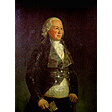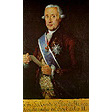

 |
Goya was highly appreciated in his time as a portrait painter. Portraits formed the greater part of his production and were his main source of income (he charged between 10,000 and 15,000 reales for a portrait in 1800). The satisfaction of the customer brought new commissions or purchases of other works, as was the case with the Duke of Osuna. Goya captivated his clients with the profound psychological quality of his portraits, quickly but well painted, and the naturalness of the study, although he did not hesitate to use a grid when he thought it necessary. His brushwork was based on the "strategy of illusion", learnt from Velazquez. Goya adopted any innovation he discovered in the extensive Royal collection, on his travels or in his friends' houses and used them in the service of his art. His long life and his keenness to learn explain his ever-changing and protean style.
See the portraits of:BibliographyGLENDINING, Nige. Goya : La década de los Caprichos : Retratos 1792-1804. Madrid, 1992. (Catalogue of the exhibition held in the Academia de San Fernando, Madrid).TOMLINSON, Janis A. Goya en el crepúsculo del Siglo de las Luces. Madrid, 1993. (Or. ed. in Eng.: Goya in the Twilight of Enlightenment. New Haven & London, 1992). Ricardo Centellas |
|
| The Duke of Osuna's Family |  |
|
| The Duke of Osuna |  |
|
| The Infante Carlos María Isidro of Bourbon |  |
|
| José Moñino, Count of Floridablanca |
 |
InfoGoya 96 is an initiative of the University of Zaragoza, sponsored by the Institution Fernando el Católico of the Deputation of Zaragoza on an Apple Internet Server donated by Apple Computer. |    |